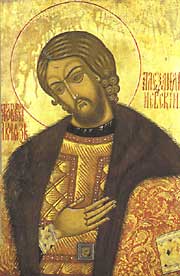Kazimir Malevich
| Kazimir Malevich | |
|---|---|
.jpg) Self-Portrait, 1912 |
|
| Birth name | Kazimir Severinovich Malevich |
| Born | 23 February 1879 Kiev Governorate of Russian Empire |
| Died | 15 May 1935 (aged 57) Leningrad, Soviet Union |
| Nationality | Russian Empire, Soviet Union |
| Field | Painting |
| Training | Moscow School of Painting, Sculpture and Architecture |
| Movement | Suprematism |
| Works | Black Square, 1913; White on White, 1918 |
Kazimir Severinovich Malevich (Russian: Казимир Северинович Малевич, Polish: Kazimierz Malewicz, Ukrainian: Казимир Северинович Малевич [kazɪˈmɪr sɛʋɛˈrɪnoʋɪtʃ mɑˈlɛʋɪtʃ], German: Kasimir Malewitsch, Belarusian: Казіме́р Мале́віч), (February 23, 1879, previously 1878: see below – May 15, 1935) was a Russian painter and art theoretician, born in Ukraine of ethnic Polish parents. He was a pioneer of geometric abstract art and the originator of the Avant-garde Suprematist movement.
Contents |
Life and work
Kazimir Malevich was born near Kiev in the Kiev Governorate of the Russian Empire. His parents, Seweryn and Ludwika Malewicz, were ethnic Poles,[1] and he was baptised in the Roman Catholic Church. His father was the manager of a sugar factory. Kazimir was the first of fourteen children, although only nine of the children survived into adulthood. His family moved often and he spent most childhood in the villages of Ukraine amidst sugar-beet plantations, far from centers of culture. Until age 12 he knew nothing of professional artists, though art had surrounded him in childhood. He delighted in peasant embroidery, and in decorated walls and stoves. He himself was able to paint in the peasant style. He studied drawing in Kiev from 1895 to 1896.

From 1896 to 1904 Kazimir Malevich lived in Kursk. In 1904, after the death of his father, he moved to Moscow. He studied at the Moscow School of Painting, Sculpture and Architecture from 1904 to 1910 and in the studio of Fedor Rerberg in Moscow (1904–1910). In 1911 he participated in the second exhibition of the group Soyuz Molodyozhi (Union of Youth) in St. Petersburg, together with Vladimir Tatlin and, in 1912, the group held its third exhibition, which included works by Aleksandra Ekster, Tatlin and others. In the same year he participated in an exhibition by the collective Donkey's Tail in Moscow. By that time his works were influenced by Natalia Goncharova and Mikhail Larionov, Russian avant-garde painters who were particularly interested in Russian folk art called lubok. In March 1913 a major exhibition of Aristarkh Lentulov's paintings opened in Moscow. The effect of this exhibition was comparable with that of Paul Cézanne in Paris in 1907, as all the main Russian avant-garde artists of the time (including Malevich) immediately absorbed the cubist principles and began using them in their works. Already in the same year the Cubo-Futurist opera Victory Over the Sun with Malevich's stage-set became a great success. In 1914 Malevich exhibited his works in the Salon des Independants in Paris together with Alexander Archipenko, Sonia Delaunay, Aleksandra Ekster and Vadim Meller, among others.

In 1915, Malevich laid down the foundations of Suprematism. He published his manifesto From Cubism to Suprematism. In 1915-1916 he worked with other Suprematist artists in a peasant/artisan co-operative in Skoptsi and Verbovka village. In 1916-1917 he participated in exhibitions of the Jack of Diamonds group in Moscow together with Nathan Altman, David Burliuk and A. Ekster, among others. Famous examples of his Suprematist works include Black Square (1913) and White on White (1918).
In 1918, Malevich decorated a play Mystery Bouffe by Vladimir Mayakovskiy produced by Vsevolod Meyerhold.
He was also interested in aerial photography and aviation, which led him to abstractions inspired by or derived from aerial landscapes. As Professor Julia Bekman Chadaga (now of Macalaster College [1]) has written: “In his later writings, Malevich defined the 'additional element' as the quality of any new visual environment bringing about a change in perception .... In a series of diagrams illustrating the ‘environments' that influence various painterly styles, the Suprematist is associated with a series of aerial views rendering the familiar landscape into an abstraction..." (excerpted from Ms. Bekman Chadaga's paper delivered at Columbia University's 2000 symposium, "Art, Technology, and Modernity in Russia and Eastern Europe").

After the October Revolution, Malevich became a member of the Collegium on the Arts of Narkompros, the commission for the protection of monuments and the museums commission (all from 1918–1919). He taught at the Vitebsk Practical Art School in the USSR (now part of Belarus) (1919–1922), the Leningrad Academy of Arts (1922–1927), the Kiev State Art Institute (1927–1929), and the House of the Arts in Leningrad (1930). He wrote the book The World as Non-Objectivity (Munich 1926; English trans. 1959) which outlines his Suprematist theories.
In 1927, he traveled to Warsaw and then to Berlin and Munich for a retrospective which finally brought him international recognition. He arranged to leave most of the paintings behind when he returned to the Soviet Union. Malevich's assumption that a shifting in the attitudes of the Soviet authorities towards the modernist art movement would take place after the death of Lenin and Trotsky's fall from power, were proven correct in a couple of years, when the Stalinist regime turned against formes of abstractism, considering them a type of "bourgeois" art, that could not express social realities. As a consequence, many of his works were confiscated and he was banned from creating and exhibiting similar art.
Critics derided Malevich for reaching art by negating everything good and pure: love of life and love of nature. The Westernizer artist and art historian Alexandre Benois was one such critic. Malevich responded that art can advance and develop for art's sake alone, regardless of its pleasure: art does not need us, and it never did.
Malevich's work only recently reappeared in art exhibitions in Russia after a long absence. Since then art followers have labored to reintroduce the artist to Russian lovers of painting. A book of his theoretical works with an anthology of reminiscences and writings has been published.
Malevich died of cancer in Leningrad on May 15, 1935. On his deathbed he was exhibited with the black square above him. His ashes were sent to Nemchinovka, and buried in a field near his dacha. A white cube decorated with a black square was placed on his tomb. The city of Leningrad bestowed a pension on Malevich's mother and daughter. "No phenomenon is mortal," Malevich wrote in an unpublished manuscript, "and this means not only the body but the idea as well, a symbol that one is eternally reincarnated in another form which actually exists in the conscious and unconscious person."
Date of birth
Recently Ukrainian art historians established the precise birthdate of the artist: February 23, 1879. Malevich and Ukraine, by professor D. Gorbachev, 2006, Kiev, reveals many new biographical details. French art historian Andrei Nakov re-established Malevich's birth year as 1879 (and not 1878), and argues for restoration of the Polish spelling of his name.
Posthumous sales
Black Square, the fourth version of his magnum opus painted in the 1920s was discovered in 1993 in Samara and purchased by Inkombank for $250,000.[2] In April 2002 the painting was auctioned for an equivalent of one million dollars. The purchase was financed by the Russian philanthropist Vladimir Potanin, who donated funds to Russian Ministry of Culture[3] and ultimately to State Hermitage Museum collection.[2] According to the Hermitage website, this was the largest private contribution to state art museums since the October Revolution.[3]
On November 3, 2008 a work by Malevich entitled Suprematist Composition from 1916 set the world record for any Russian work of art and any work sold at auction for that year, selling at Sotheby’s in New York City for just over $60 million U.S. (far surpassing his previous record of $17 million set in 2000).
Malevich in popular culture
- The smuggling of Malevich paintings out of Russia is a key to the plot line of Martin Cruz Smith's thriller Red Square.
- Noah Charney's novel, The Art Thief tells the story of two stolen Malevich White on White paintings, and discusses the implications of Malevich's radical Suprematist compositions on the art world.
- Song titled "Sabrina", from German Industrial Band Einstürzende Neubauten album's Silence is Sexy, includes lyrics about Malevich's Black Square
Selected works
- 1912 Morning in the Country after Snowstorm
- 1912 The Woodcutter
- 1912-13 Reaper on Red Background
- 1914 The Aviator
- 1914 An Englishman in Moscow
- 1914 Soldier of the First Division
- 1915 Black Square and Red Square
- 1915 Red Square: Painterly Realism of a Peasant Woman in Two Dimensions
- 1915 Suprematist Composition
- 1915 Suprematism (1915)
- 1915 Suprematist Painting: Aeroplane Flying
- 1915 Suprematism: Self-Portrait in Two Dimensions
- 1915-16 Suprematist Painting (Ludwigshafen)
- 1916 Suprematist Painting (1916)
- 1916 Supremus No. 56
- 1916-17 Suprematism (1916–17)
- 1917 Suprematist Painting (1917)
- 1928-32 Complex Presentiment: Half-Figure in a Yellow Shirt
- 1932-34 Running Man
Gallery
 Flower Girl, 1903 |
 Bathers, 1908 |
 Winter, 1909 |
 Taking in the Rye, 1911 |
 The Knifegrinder, 1912 |
 Head of a Peasant Girl, 1912-1913 |
 Bureau and Room, 1913 |
 Portrait of Matiushin, 1913 |
 Cow and Fiddle, 1913 |
 Englishman in Moscow, 1914 |
 Composition with the Mona Lisa, 1914 |
 Black Circle, signed 1913, painted 1915 |
 Suprematism (Self-Portrait), 1916 |
 Suprematism, Museum of Art, Krasnodar 1916 |
 Suprematism, 1921-1927 |
 Boy, 1928-1932 |
 Red-cavalry, 1928-1932 |
Summer Landscape, 1929 |
 Mower, 1930 |
 Running man, 1932 |
See also
- Aerial landscape art
- El Lissitzky
- IRWIN
- Lyubov Popova
- OBERIU
- Rabo Karabekian
- Suprematism
- Supremus
- UNOVIS
Notes
- ↑ Milner and Malevich 1966, p. x.
- ↑ 2.0 2.1 Sophia Kishkovsky (July 18, 2002). "From a Crate of Potatoes, a Noteworthy Gift Emerges". The New York Times. http://www.nytimes.com/2002/07/18/arts/arts-abroad-from-a-crate-of-potatoes-a-noteworthy-gift-emerges.html. Retrieved 2009-08-23.
- ↑ 3.0 3.1 "Co-operation With the State Hermitage Museum". State Hermitage Museum. http://www.hermitagemuseum.org/html_En/05/hm5_4_0.html. Retrieved 2009-08-23.
References
- Andrei Nakov Kasimir Malevich, Catalogue raisonné, Paris, Adam Biro, 2002
- Andrei Nakov vol. IV of Kasimir Malevich, le peintre absolu, Paris, Thalia Édition, 2007
- The Non-objective World, Kasimir Malevich, trans. Howard Dearstyne, Paul Theobald, 1959. ISBN 0486429741
- Kazimir Malevich and Suprematism 1878-1935, Gilles Néret, Taschen, 2003. ISBN 0874141192
- Dreikausen, Margret, "Aerial Perception: The Earth as Seen from Aircraft and Spacecraft and Its Influence on Contemporary Art" (Associated University Presses: Cranbury, NJ; London, England; Mississauga, Ontario: 1985). ISBN 0-87982-040-3
- Milner, John; Malevich, Kazimir, Kazimir Malevich and the art of geometry, Yale University Press, 1966. ISBN 0300064179
- Shishanov V.A. Vitebsk Museum of Modern Art: a history of creation and a collection. 1918–1941. - Minsk: Medisont, 2007. - 144 p.Mylivepage.ru
- Kazimir Malevich in the State Russian Museum. Palace Editions. ISBN 978-3930775767. (English Edition)
- Malevich and his Influence, Kunstmuseum Liechtenstein, 2008. ISBN 978-3-7757-1877-6
- Ivanov, Sergei."Unknown Socialist Realism. The Leningrad School". Saint Petersburg: NP-Print, 2007, ISBN13 9785901724217
External links and references
- All Paintings of Kazimir Malevich
- Andrei Nakov's works on Kazimir Malevich
- Guggenheim: Kazimir Malevich
- "White on White"
- DA Collection
- Kazimir-Malevich.org - 128 works by Kazimir Malevich
- "Victory Over the Sun" discussed
- Das schwarze quadrat (The Black Square) - Exhibition at Kunsthalle Hamburg
- Lawsuit over ownership of Malevich's Paintings Settled
- Less known paintings and photographs from private collection
- Sergei V. Ivanov. The Leningrad School of painting. Historical outline
- Kazimir Malevich Website
|
|||||||||

.jpg)